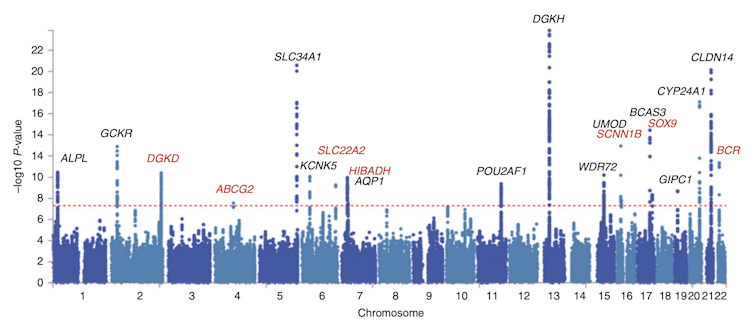In a recent article from Nature Genetics_, scientists raise concerns over the social impacts of recent advances in genomics – i.e. the study of genomes, or in other words, the genetic material of an individual or species. In passages bringing to mind the dystopian sci-fi film Gattaca, they describe a near future in which one’s DNA could foretell one’s physical and intellectual abilities and near-perfect children be conceived in vitro.
Indeed, on the surface, it would appear reality is catching up with fiction. We now live in a world where it is now possible to look at the entire genome in a bid to identify the genetic causes of complex diseases. Recent research in genome-wide association studies (GWAS) claims to have pinned down the genetic variants responsible for developing diseases or traits such as drug addiction, antisocial behaviour or intellectual aptitudes.
However, these views are flawed because they are based on a series of errors and misunderstandings; we will now proceed to unpacking them.
What is a GWAS?
GWAS seek to highlight differences in allele frequency of markers depending on the expression of the studied trait. The markers can be considered as small flags planted along the genome, each flag having two possible colours (the alleles). The idea behind GWAS is that an association between a marker and a trait allows for the detection of genetic factors independently of environmental factors. This can be done both on quantitative traits (such as height) and diseases.
In the latter case, scientists compare markers between groups of affected and healthy individuals. Each identified marker is then assigned a coefficient that is supposed to represent the strength of its association with the disease. An overall score – known as the Polygenic Risk Score – is finally calculated to represent the level of risk of developing the disease in question.
A new market
As early as 2007, companies began selling disease risk predictions based on saliva samples. Located in South San Francisco, the biotech and genomics company 23andMe collected over a million DNA samples before being ordered by the FDA in 2013 to cease its activities for want of clinical evidence.
23andMe managed to keep its doors open by changing its approach and collecting DNA to map out the geographical origins of people’s ancestors. An important part of these DNAs has been made available to scientific teams, allowing them to perform and publish GWAS on huge samples. Initially carried out on hundreds of individuals, GWAS rapidly expanded to millions of people. In the past fifteen years, many studies have claimed to have detected genetic factors that could predict not only our risk of disease, but also our intellectual abilities or social adaptation.
For example, a 2018 study on the educational achievements of nearly 270,000 individuals said it had identified more than a thousand genetic factors responsible for “intelligence”. Four years later, a study based on 3 million individuals found the number of genetic factors multiplied by 4. In this spirit, a simple DNA swab would be enough to predict the number of years we were destined to study or whether we would end up as serial smokers or alcoholics.
The mistaken assumptions behind Polygenic Risk Scores
The problem is that these conclusions are based on erroneous assumptions and misinterpretation of associations between the traits to be predicted and genetic markers.
Indeed, Polygenic Risk Scores are specifically based on assumptions put forward in 1965 by Douglas Scott Falconer. Among these hypotheses, it is excluded from the outset that an environmental factor can play an important role in the expression of the trait, even though we know how much lifestyle choices can impact our health. Environmental factors are also thought to impact the individual at random – regardless of their family, social and professional conditions. Last but not least, it is assumed that the pathological processes at the root of the disease are the same for all, when we know that all diseases are very heterogeneous.
Misinterpretations of the GWAS studies
Another problem is that Polygenic Risk Scores are based on a flawed interpretation of the GWAS studies. For if the link between a trait and genetic marker could indeed indicate a genetic factor, this remains to be confirmed by subsequent family and functional studies. Associations could just as well reflect environmental or cultural factors.
For example, a GWAS study comparing people in France who consume salted butter with those who consume unsalted butter would show a large number of genetic markers associated with this trait. Not because it would reveal genetic factors conferring a particular taste for salted butter, but because these markers differ between Brittany and other French regions. The problem of interpreting associations also arises for traits that are due to complex interactions between genetic and environmental factors. For example, associations observed between markers and body mass index (BMI) may reflect sociocultural differences, particularly differences in eating habits. This will also be the case for all diseases associated with BMI (diabetes, cardiovascular diseases, breast cancer etc.).

Sarah A. Howles/Wikipedia, CC BY
These false conclusions have serious consequences, as clinicians increasingly turn to risk calculation tools based on these scores.
Sociological consequences
Already denounced in 1975 by Marcus Feldman and Richard Lewontin and in 1978 by Albert Jacquard, the fanciful interpretations of the Intelligence Quotient (IQ) have resurfaced with the idea that your IQ can be predicted from birth based on your DNA.
The IQ variable was originally thought out as a tool to measure the adequacy of a child to a given school programme. It is not a universal and timeless measure of cognitive abilities, or even of intelligence. Even if we restrict ourselves to France, we cannot compare the mental arithmetic performance of children aged 9 today with those of a century ago, for the simple reason that they were not trained in the same way.
Unfortunately, many so-called “socio-genomic” studies are advancing the idea that we are genetically predetermined to perform well or poorly in school. These ideas are widely disseminated by the scientific press, the mainstream media and books by psychologists such as Paige Harden and Plomin. In light of these ideas, we would be forgiven for asking ourselves about the point of promoting education for all when some are, so to speak, “genetically impervious”.
Ethical implications
Polygenic scores are also used by some to differentiate populations according to traits such as intelligence, thereby justifying racist views or eugenic behaviour.
For example, in the journal “Intelligence ” , after comparing IQ score of different geographical areas, the author concluded that the genetic factors contributing to intelligence had been subjected to selection pressure during migration and would explain a higher intelligence in the European population than in the African population.
In his presidential address to the American Society of Human Genetics in 2015 [https://pubmed.ncbi.nlm.nih.gov/26942276/ref], geneticist Neil Risch mischievously commented the approach and conclusions. He calculated the scores of Craig Venter (pioneer of human genome sequencing) and James Watson (co-discoverer of the DNA structure). The result was that both have a score below the European average. Risch humorously concluded that a below-average score was enough to land a Nobel Prize or the Medal of Science.
A flawed genetic model
In addition to Nature Genetics, journals such as Science, or societies devoted to human genetics appear rightly concerned about the slippery slope toward genetic determinism we find ourselves on. But they merely raise ethical issues, failing to stress, in the process, that the root of the problem remains an inappropriate genetic model and the misinterpretation of associations with genetic markers.
It would be easy to caricature the scientific debate by labelling those who question the validity of genetic predictions as ‘environmentalists’. Yet to deny the validity of genetic predictions of complex traits is not to deny the effect of genetic factors on these traits. Rather, it is to challenge the assumptions on which these predictions are based.
On a more positive note, these concerning developments should not obscure the valuable contribution of these new technologies when deployed correctly. In particular, studies described as “ post-GWAS ” have made it possible to highlight the role of certain genes or gene networks in diseases whose causes remain difficult to pin down (cancers, neurological diseases…).




